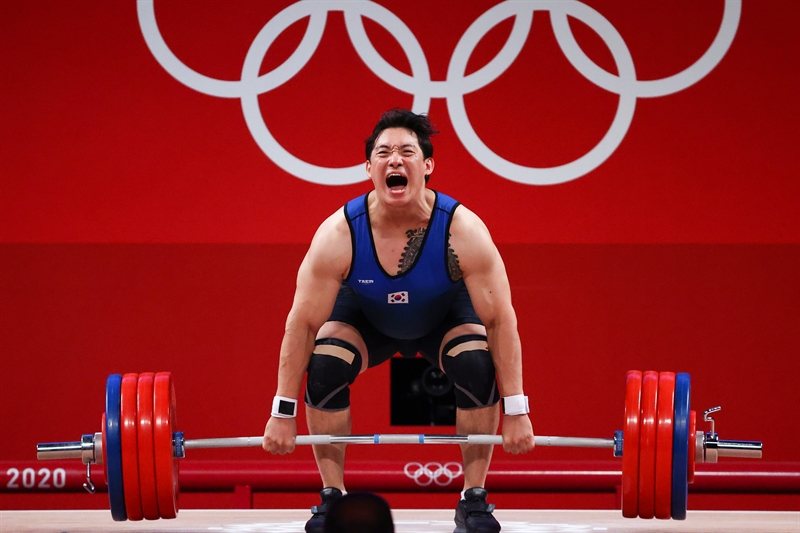You are viewing 1 of your 1 free articles
Slowing down to speed up - restoring strength with isometric and eccentric training

The increase in sports participation and higher intensity of competition results in improved performance. However, this may predispose a greater risk of sports injuries, with musculotendinous injuries such as hamstring and Achilles tendon strains being some of the most commonly occurring injuries. Sustaining such injuries leads to a decrease in physical attributes, such as muscular strength, strength ratios, rate of force development, reactive strength, leg stiffness, and the ability to generate high muscular power. As these attributes are considered essential determinants in high-performance sport, rehabilitation programs should include high force, low-velocity and low force, high-velocity movements to enable a full spectrum of adaptations. This would better prepare athletes to return to sports (RTS).
Isometric training
Isometric training involves the muscles producing force without any external movement. Athletes can perform isometric training by maintaining a specific joint position while resisting a specific load (hold) or exerting force against a stationary object (push). While the current literature has not provided evidence on the difference in physiological adaptations to these two forms of isometric training, it is worth noting that the hold isometric method only allows for a submaximal contraction while the push method allows for both submaximal and maximal voluntary contraction.Isometric training has a positive effect on pain management(1). For example, five repetitions of isometric knee extension for 45 seconds at 70% maximal voluntary contraction results in reduced patellar pain for 45 minutes(1). As pain is often present during the acute healing stages, being able to perform rehabilitation exercises while reducing the perception of pain may increase adherence to a rehabilitation program. In addition to pain reduction, performing isometric contractions before heavy eccentric loading minimizes the sensation of delayed onset muscle soreness (DOMS)(2).
Another reason for adopting isometric training into the rehabilitation program is its beneficial effect on improving tendon stiffness, a physical attribute that is important for reducing the risk of tendon injury and improving the rate of force development. Researchers at the University of Tokyo in Japan report that isometric training is more effective in increasing tendon stiffness than heavy resistance and plyometric training(3). Therefore, isometric training may be the preferred training mode when rehabbing a tendon injury. There are several factors to consider when performing isometric training to improve tendon stiffness. Firstly, adopting a joint position that induces long muscle length is more effective in enhancing tendon stiffness (e.g., when performing isometric leg extensions, adopting a 90o knee angle will benefit patellar tendon stiffness more than adopting a 150o knee angle). Secondly, a long-sustained contraction per repetition will benefit tendon stiffness more than a short sustained contraction (e.g., a protocol involving 3 x 30 seconds contraction will result in greater tendon stiffness than 30 x 3 seconds contraction).
____________________________________________________________________
Benefits of isometric training
| 1. Enhance joint angle specific force production capability |
| 2. Enhance tendon stiffness |
| 3. Increase strength more than heavy resistance training alone |
| 4. Improve rehabilitation outcomes |
____________________________________________________________________
One of the main objectives of rehabilitation is to restore muscular strength as the muscle's ability to generate force is reduced after sustaining an injury. While isometric strength is less effective in improving dynamic strength than a dynamic training mode, it is more effective in improving joint angle-specific strength(4). Therefore, to increase strength throughout a larger range of movement, it is recommended to perform isometric training at either a joint position that induces long muscle length or at multiple joint positions(4). In addition, contraction intensity closer to maximal voluntary contraction (>80%) has more significant benefits on strength improvement. Furthermore, sustaining the high-intensity contraction for <3 seconds increases maximal strength more than shorter contractions (~1 second) (see table 1)(5).
Another important physical attribute important for sports performance is the rate of force development, i.e., the ability to generate force rapidly. Researchers at the
Singapore Sport Institute report that performing ballistic isometric contractions leads to improvements in the rate of force development(4). However, in contrast to increasing muscular strength, if athletes sustain the contraction for too long, it may lead to an interference effect, and the improvement to the rate of force development will be compromised. Therefore, when athletes approach end-stage rehabilitation, practitioners can prescribe ballistic isometric contractions with a short duration of sustained contraction (1-3 seconds) to enhance the rate of force development (see table 1).
Table 1: Isometric training
| Objective | Contraction Duration | Intensity | Volume | Joint Position | Frequency |
|---|---|---|---|---|---|
| Pain management | 10 — 30 s per repetition | Pain level within tolerance | 80-150 s per session | A position that induces long muscle length or multiple joint positions | 2 — 3 sessions/week |
| Strength maintenance | Slow contraction | ||||
| Tendon stiffness | 10 — 30 s per repetition | 70% maximal voluntary contraction | 80-150 s per session | ||
| Muscle hypertrophy | Slow contraction | ||||
| Maximum strength | 3 — 10 s per repetition | >80% maximal voluntary contraction | 30 — 90 s per session | ||
| Slow or rapid contraction | |||||
| Rate of force development | 1 — 3 s per repetition | >80% maximal voluntary contraction | 30 — 45 s per session | ||
| Rapid contraction |
Eccentric Training
Eccentric training involves the lengthening of muscles while resisting a given load. Eccentric muscle actions produce a more significant amount of force than concentric muscle actions. For example, heavy eccentric training (supramaximal concentric load) improves muscular strength more than traditional strength training, which includes submaximal concentric and eccentric training. Therefore, athletes' training often includes eccentric training as concentric force production does not limit load prescription.Furthermore, eccentric training increases muscle fascicle length, which is associated with a lower risk of muscular injury(6,7). For example, one study reported that athletes with a Biceps Femoris fascicle length of less than 10.46cm had a 4.1 times greater risk of sustaining a hamstring injury. This is likely because longer fascicles, with a higher amount of in-series sarcomeres, may be less likely to be over-stretched and have damage caused by powerful eccentric contractions, such as the leg swing during maximal sprinting. In addition, active muscle stiffness improves with eccentric training(3). While increased tendon stiffness may reduce the risk of tendon injury and increase storage of elastic energy when stretched, high active muscle stiffness is required to prevent muscle rupture when high tendon stiffness is present. In addition, increased muscle stiffness also enables the stiff tendon to be stretched to greater length during the stretch-shortening cycle action.
As eccentric training may lead to DOMS and possible discomfort during exercise, isometric training may be beneficial in reducing pain before starting the eccentric component of the program. The American College Position Stand recommends that eccentric training be performed with 6-12 repetitions over four sets to emphasize strength in the muscle-tendon complex(8). The athlete will use the load that allows for six repetitions and build up to 12 repetitions over several sessions before progressing (see table 2). Athletes should perform the concentric phase of the exercise with assistance until they can perform it without pain while performing the eccentric phase independently.
Table 2: Eccentric training
| Mode | Objective | Intensity | Volume | Frequency | Remarks |
|---|---|---|---|---|---|
| Free or stack weights | Increase strength | Pain level within tolerance | 4 x 6-12 repetitions / session | 2 — 3 sessions/week | Increase load when the athlete can perform ‰¥12 repetitions per set. |
| Increase fascicle length | Slow contraction | Assisted concentric phase until the athlete can perform it pain-free. | |||
| Plyometrics (low to moderate intensity) | Increase rate of force development | 80 — 100% maximal voluntary contraction | 80 — 140 contacts | Bilateral low to moderate intensity exercises, for example: | |
| Increase active muscle stiffness | Rapid contraction | - Pogo hop | |||
| - Unloaded vertical jump | |||||
| - Box jump | |||||
| - Countermovement jump | |||||
| - ‰¤30 cm drop jump | |||||
| Plyometrics (moderate to high intensity) | Increase rate of force development | 80 — 100% maximal voluntary contraction | 80 — 140 contacts | Bilateral and unilateral moderate to high-intensity exercises, for example: | |
| Increase active muscle stiffness | Rapid contraction | - Bounding | |||
| - Tuck jump | |||||
| - Long jump | |||||
| - Hurdle hop | |||||
| - >30 cm drop jump |
Plyometric training
Plyometric training involves a rapid stretch-shortening muscle contraction cycle, which closely replicates how the muscle works in most sports. Therefore, practitioners should include this training mode in the later stage of rehabilitation programs to better prepare athletes for RTS. Plyometric training can commence when the athlete can perform moderate loading during traditional strengthening exercises and functional movement patterns, such as running, with proper form. As plyometric training involves rapid eccentric and concentric action and high impact force, practitioners should carefully monitor the intensity to reduce reinjury risk. Therefore, practitioners can utilize the following strategies to introduce plyometric training into rehabilitation gradually, (1) perform resistance band unloaded plyometrics; (2) perform plyometric training on a softer surface (e.g., sand or gymnastic mats); (3) progress from lower intensity bilateral exercises such as pogo hops, low height box jump to higher intensity bilateral and unilateral exercises such as tuck jumps, drop jump (>30 cm), and bounding. The initial volume for plyometric training should be between 80 to 100 contacts per session. This can then be increased up to 140 contacts per session as the athlete progresses (see table 2). Practitioners must consider an athlete's technical proficiency and tolerance level when progressing from low to high-intensity plyometric exercises and increasing repetitions.Conclusion
The main objective of a rehabilitation program is to help athletes RTS safely and reduce the risk of future injury. Current literature supports the use of both isometric and eccentric training during the rehabilitation process as these training modes effectively improve muscular strength, rate of force development, and musculotendinous stiffness. These are important physical attributes for performance and injury reduction. Therefore, practitioners should include these training modes in the rehabilitation program of their injured athletes.References
- Br J Sports Med. 2015. 49(19):1277-83.
- Physiol. Nutr. Metab. 2012. 37(4):680–89.
- Physiol Reports. 2017. 5(15):e13374
- Int J Sports Med. 2019. 40(6):363-75
- Sci Sport Exerc. 2021. 3(2):115-24.
- Br J Sports Med. 51(5):469-77.
- Br J Sports Med. 50(24):1524-35.
- Med Sci Sports Exerc. 2009. 41(3):687-708.
Newsletter Sign Up
Subscriber Testimonials
Dr. Alexandra Fandetti-Robin, Back & Body Chiropractic
Elspeth Cowell MSCh DpodM SRCh HCPC reg
William Hunter, Nuffield Health
Newsletter Sign Up
Coaches Testimonials
Dr. Alexandra Fandetti-Robin, Back & Body Chiropractic
Elspeth Cowell MSCh DpodM SRCh HCPC reg
William Hunter, Nuffield Health
Be at the leading edge of sports injury management
Our international team of qualified experts (see above) spend hours poring over scores of technical journals and medical papers that even the most interested professionals don't have time to read.
For 17 years, we've helped hard-working physiotherapists and sports professionals like you, overwhelmed by the vast amount of new research, bring science to their treatment. Sports Injury Bulletin is the ideal resource for practitioners too busy to cull through all the monthly journals to find meaningful and applicable studies.
*includes 3 coaching manuals
Get Inspired
All the latest techniques and approaches
Sports Injury Bulletin brings together a worldwide panel of experts – including physiotherapists, doctors, researchers and sports scientists. Together we deliver everything you need to help your clients avoid – or recover as quickly as possible from – injuries.
We strip away the scientific jargon and deliver you easy-to-follow training exercises, nutrition tips, psychological strategies and recovery programmes and exercises in plain English.










